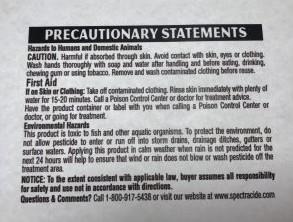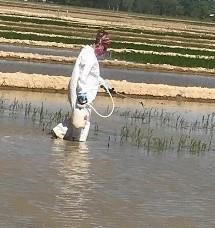By Entomology Emily
Have you ever bought a product to manage pests or diseases at home and wondered what PPE do I need to use this product? You are not alone! Pesticide labels may seem straightforward to those of us in the industry or to certified applicators. However, they can be very confusing to homeowners trying to protect their lawns and gardens. I will try to describe how pesticide labels are organized and specifically where to look for your PPE needs.
The label is the law
Some of you may have heard the phrase, “The label is the law”. It is a well-known saying in certified applicator circles and in the literature on pesticide safety. This saying refers to the EPA-approved labels that are on all pesticide products. According to the EPA, “It is a violation of Federal law to use this product in a manner inconsistent with its labeling.” In other words, the label is the law. These labels are a binding contract between you and the government saying you will follow all of the “rules” they have listed. You can be fined for not following these requirements or worse put yourself or the environment at risk.
Where is the PPE stuff?
The Pesticide Information Office has previously written several blogs on, how to read a pesticide product label. These are very useful for certified applicators and homeowners alike. The EPA also has a webpage with more technical information on labels. Pesticide product labels generally follow the same

outline which allows a user to find the needed information quickly. The PPE stuff will be under the “Precautionary Statements” part of the label. This product would require pants, shoes, long-sleeves and gloves. Not wearing all of these items would be illegal.
However, if you are a homeowner using what we call a ready-to-use product you may find that the PPE is not listed. You can see in the label below no PPE is listed. Why would this be?

In products for homeowners, there may not be any amount of PPE that is actually required by law. This would be the case if it had been determined by the EPA that the risk imposed by this product is not great enough to make it a legal requirement. Many ready-to-use or CAUTION label products contain less than 1% of the active ingredient. These pose a very minimal risk compared to products with the same active ingredient in a higher concentration.
The label should be in this order but unfortunately, some companies don’t follow this format. You should always be able to scan through for the “Precautionary Statements” and find the required PPE even if for some reason it has been organized differently.
Can I wear extra PPE?
Yes! You are always able to wear more than what the label suggests. The label states all PPE that is required by law for the product. This does not mean that you can’t wear more PPE than is required. If there is no required PPE there is generally a statement that says to wash your hands and clothes and not to eat during application. You are certainly able to wear PPE in addition to following these statements. I would personally wear at minimum closed-toe shoes, pants, and gloves, but it is not the law.
 This was me spraying insecticide in a rice field. The label did not require a respirator but I chose to wear one anyway.
This was me spraying insecticide in a rice field. The label did not require a respirator but I chose to wear one anyway.So what should homeowners do?
Of course, everyone using a pesticide should follow the label. It is a great idea to read through the entire label to make sure you are using the product as intended. Remember these are chemicals that are being used to kill insects, fungi, and plants. They can be harmful if not used correctly. If you are wondering, what PPE do I need?, you should look under the “Precautionary Statements” section and see what is listed. Beyond what is listed you can wear any additional gear you feel will protect you.
Source : ufl.edu